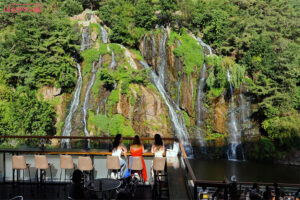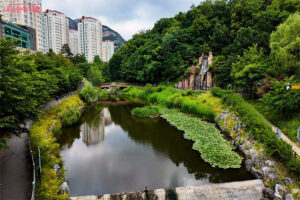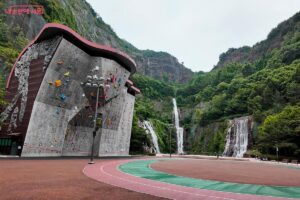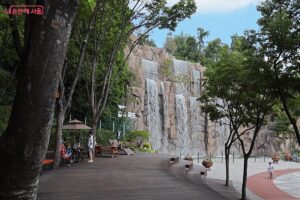
1. Hongje Waterfall: A Riverside Oasis Loved by Youth and Tourists

Urban Yet Natural
Located in Seodaemun-gu along the Hongjecheon Stream, Hongje Waterfall was built in 2011 and stands 25 meters high and 60 meters wide. With its powerful cascade, it feels surprisingly natural despite being man-made. It’s a favorite for both locals and foreigners, often bustling with people looking for peace or that perfect Instagram shot.
Things to Enjoy Nearby
The surrounding area offers beanbag chairs, a terrace, and the aptly named “Café Waterfall.” This riverside café and its open-air seating create a laid-back vibe. Add to that a restored watermill, stepping stones, and the forested Yeonhui Rest Area for a romantic or solo stroll alike.
How to Get There
- Operating Hours: Open year-round, 08:00–21:00
- Subway Line 3, Hongje Station Exit 4 (홍제역 4번 출구) → Bus 7713 or 7738 → Baengnyeon-gyo Stop (백련교 정류장) → 4-minute walk
- View on Google Maps | View on Naver Map
2. Gupabal Artificial Waterfall: A Quiet Streamside Sanctuary

Natural Appeal in the City
Tucked beneath the Grasshopper Bridge in Jingwan-dong, Eunpyeong-gu, this two-tier, 9-meter-high waterfall is part of the Gupabalcheon Stream. The waterfall feeds into a pond filled with koi fish and is surrounded by seasonal wildflowers—ideal for travelers seeking quietude in Seoul.
Peaceful Walks and Meditative Vibes
Wooden benches and walking paths let you slow down and breathe. You’ll hear only the water, wind, and the occasional chirping bird. Combine this with a visit to nearby Jingwansa Temple or Eunpyeong Hanok Village for a full day of tranquil exploration.
How to Get There
- Operating Hours: April–October, 4 daily runs (13:00–14:00, 15:00–16:00, 18:00–19:00, 20:00–21:00)
- Subway Line 3, Gupabal Station (구파발역) → Bus 7211, 706, 720, or 7734 → Eunpyeong Police Station Stop (은평경찰서 정류장) → 2-minute walk to the Grasshopper Bridge
- View on Google Maps | View on Naver Map
3. Yongma Waterfall Park: Asia’s Largest Artificial Waterfall

A Cascade from the Quarry Cliffs
Once a rock quarry, Yongma Waterfall Park in Jungnang-gu now features Asia’s tallest artificial waterfall—51.4 meters high! It’s flanked by two others: Cheongryong (21m) and Baengma (21.4m). When the falls are running, they roar mightily, refreshing the senses and your camera roll.
Activities and Amenities
The site also includes a full-sized rock-climbing wall, forest paths, and a dirt walking trail. A splash zone for kids opens in summer, making it ideal for families, couples, and adventurers alike.
How to Get There
- Operating Hours: May 7–August 31, 3–5 daily runs (including night hours during peak season)
- Subway Line 7, Yongmasan Station Exit 2 (용마산역 2번 출구) → 5-minute walk
- View on Google Maps | View on Naver Map
4. Baebongsan Forest Waterfall: A Night-Lit Oasis in the Woods

Nature and Lighting Beneath the Moonlight
Located at the Open Plaza of Baebongsan Neighborhood Park in Jeonnong-dong, Dongdaemun-gu, this waterfall was newly established in 2024. Water cascades from a 19-meter-high artificial cliff with a 34-meter-wide spread, illuminated at night for a dreamlike ambiance. During July and August, it operates until 9 PM, providing cool mist even on hot Seoul evenings.
Cozy Resting Areas and Forest Walks
The area offers shaded tables and chairs, making it perfect for picnics or dates. Nearby trails and a public library enhance the appeal for both relaxation and cultural discovery.
How to Get There
- Operating Hours: April–October, 7–9 daily cycles (on the hour to 30 min); July–August includes evening hours until 9 PM
- Bus 2013, 2015, 2230, 2233 → Jeonnong-dong SK Apartment Stop (전농동 SK아파트 정류장) → 5-minute walk
- View on Google Maps | View on Naver Map
Conclusion: Waterfalls as Healing Codes in Seoul’s Urban Jungle
Seoul is more than just a metropolis. Between towering buildings and bustling streets, serene streams and cascading waterfalls reveal a quieter, softer side of the city. These four waterfall spots go beyond visual pleasure—they are “pauses” in the rhythm of the city, offering relief from stress and reconnection with nature. With accessible public transportation and handy map links, these oases are just a subway ride away. So why not trade the noise for the sound of falling water, and screen time for forest time? Your Seoul just got a little cooler.